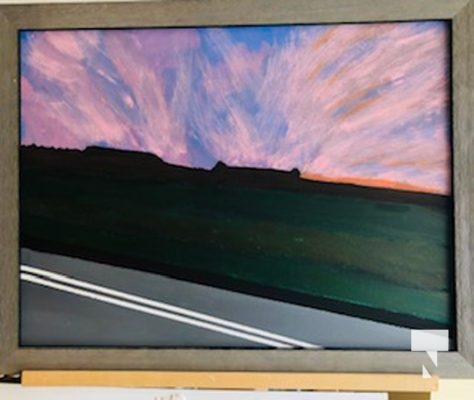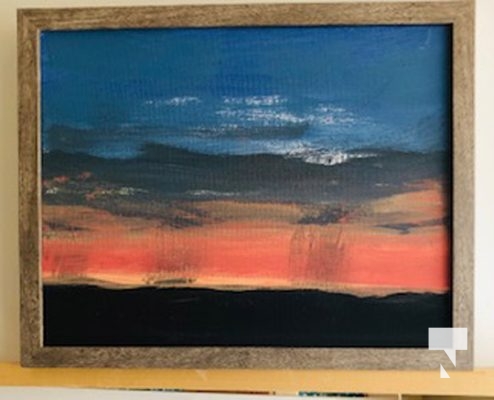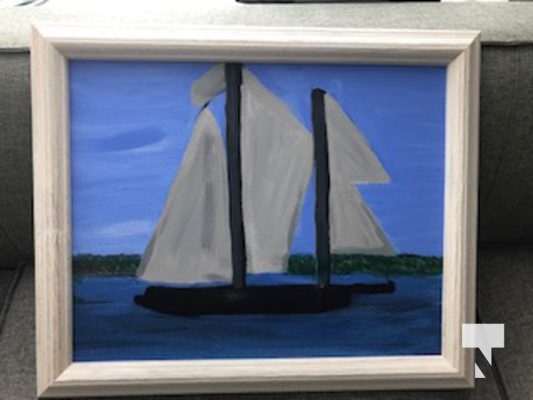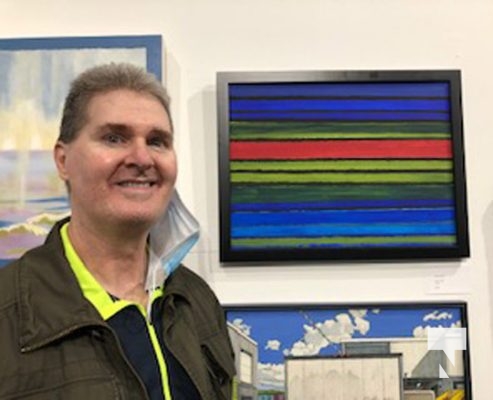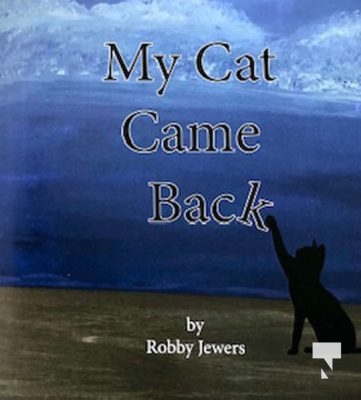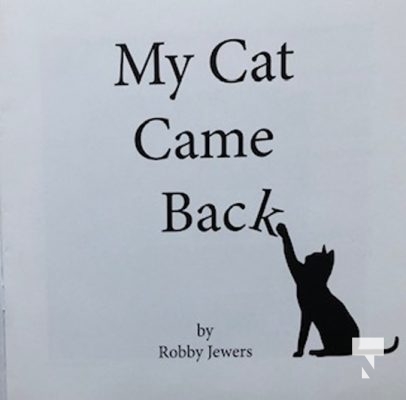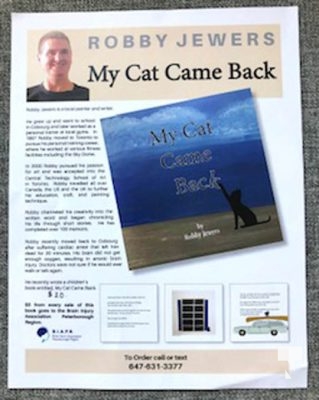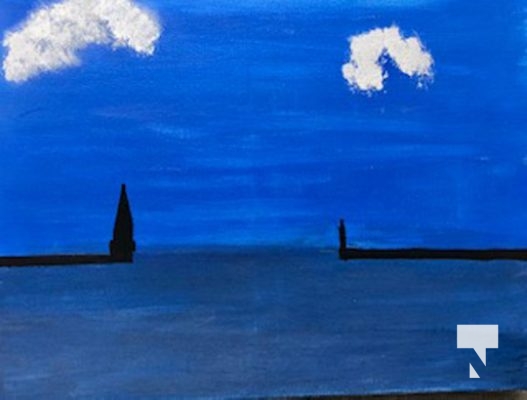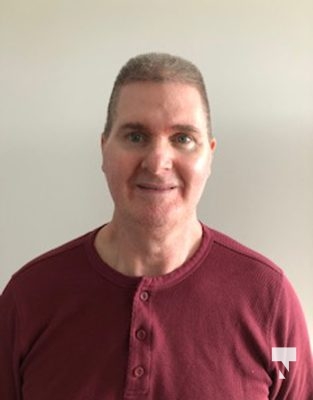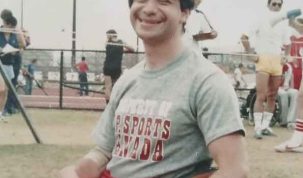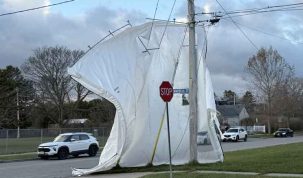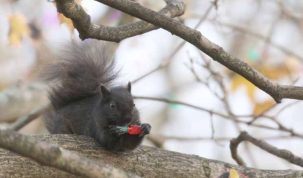By Cecilia Nasmith/Today’s Northumberland
It is not widely known that June is Brain Injury Awareness Month, but Cobourg residents Jacqueline Quemby and Robby Jewers want to do what they can to spread the word.
The couple are experts on the subject, not only through research but through lived experience.
Jewers suffered anoxic brain injury in 2015 as the result of cardiac arrest. During the 20 minutes it took to revive him, 20 minutes during which he was clinically dead, his brain did not get enough oxygen.
Quemby has been by his side every step of the way through his rehabilitation, working with doctors and therapists and learning everything she can about what her husband is experiencing.
A so-called Acquired Brain Injury is damage to the brain that occurs after birth (as opposed to being a congenital or degenerative disorder). It may occur through trauma (such as a sports injury or blow to the head) or a non-traumatic event (as in Jewers’s case).
Quemby was delighted that the Brain Injury Society of Canada arranged to have the CN Tower lit up in green and blue June 3 in support of Brain Injury Awareness.
“It’s interesting that there’s just not much collective awareness about brain injury itself,” she said in a recent interview.
“When I was doing my research, I was astounded at the numbers.”
Quoting figure from the Brain Injury Association of Durham, she said that each day brings 144 new brain injuries in Ontario alone. This year, 795 Ontario children out of 100,000 will suffer a brain injury, and current numbers show about half a million Ontarians are identified as having an AIB.
In Canada each year, 150,000 will suffer an Acquired Brain Injury. It is anticipated that, somewhere in Canada, a brain injury will occur every 3.5 minutes.
Quemby wonders if the lack of awareness isn’t because of the fact that it’s not something visible to the casual observer.
“You couldn’t look at Robby and think, ‘he has a brain injury,’” she pointed out.
“We know lots of people have brain injury, and they are functioning people in society. But given certain circumstances, certain situations, then the effects of brain injury come out.”
Following Jewers’s surgery, they felt as if they were starting at square one as they devoted four months of intensive work to get him walking again. But he had one thing going for him that not every brain injury-recovery patient has – awesome physical conditioning.
This began during a boyhood full of NHL dreams. He threw himself into the game and, along the way, was a star defenceman in local hockey leagues. At CDCI East, he was part of the school’s last football team in 1979. But no matter what the sport, he kept in peak shape by working out.
Eventually it was the bodybuilding that became his focus, and he began to shuttle between Cobourg and California to compete and train – even landing a job with Mattel to play the role of their He-Man action figure in personal appearances with delighted young fans.
Jewers moved to Toronto in 1997 to head up personal training at Sky Dome, and that’s where he was living when his life took a surprising turn – he discovered a deep-seated love of art.
He is still somewhat surprised that it happened.
“For some reason, on a whim, I just got this urge,” he recalled.
Even during all those years of drive and accomplishment in sports and athletics, Quemby said, her husband always had an artistic side. He would occasionally write poetry and did beautiful calligraphy.
Jewers recalls pursuing these creative outlets, and recalls how much he always enjoyed looking at the beautiful results each time he finished a calligraphy project.
When the art bug bit in Toronto, he put together a portfolio, took the plunge and enrolled in a three-year art course at Central Technology School of Art.
Jewers admits some regret over missing that third year, but both he and Quemby agree it was well spent travelling and seeing art in the real world – London, Paris, all over the US, including the National Gallery of Art in Washington, DC.
Jewers said the visual acuity of seeing great works seemed imperative at the time. He describes it as a “lust-for-life kind of thing.”
The result, in his own art, was a spirit of exploration that led him to the abstract expressionist style he loves. He found his work represented by a couple of different galleries in Toronto and had pieces sold to collections in Canada and the US. One of his proudest accomplishments was his work being purchased by Canada’s richest man, art collector Kenneth Thomson
“He was a sold artist!” Quemby marvelled.
When they discuss his work, they talk about his before-cardiac-arrest period and his after-cardiac-arrest period. After all, the cardiac arrest happened when, as Quemby put it, he was in the throes of painting. They had to pack up some of his masterpieces to put away while the concentrated on his recovery. Now that so much of the heavy lifting is done, they are enjoying the prospect of more sales and exhibitions. The Ganaraska Art Gallery is featuring some of this previously stored work, and some of his more recent paintings have been featured in art shows at the Art Gallery of Northumberland. It’s like a link between his painting before and his painting after, Quemby said.
Jewers has also rediscovered his love for writing – rediscovered, Quemby said, since it was something else he did before his cardiac arrest, turning out hundreds of stories largely based on events in his life.
Some are humourous, some point out interesting things that happened and some, Jewers said, have deeper meanings.
“After our long recovery of a year in the hospital in Toronto, Robby’s creative brain was probably dormant because his left brain was so busy just trying to learn everything,” Quemby said.
“So the creative part was a bit dormant. It took a while because we were in hospital having to learn everything all over again – walking, talking.”
His course of rehabilitation included the chance to paint again but, for whatever reason “it didn’t speak to him. I don’t think it was connecting. We left it for a bit and went home, pursued more therapy.”
They also connected with the Brain Injury Association of Peterborough.
“They were just amazing. They thought maybe, if he’s not taking to the painting right now, what if we went to writing stories. Robby could just talk, they would put down his words.”
“It clicked for me,” Jewers declared.
“It sparked something in my soul, I think.”
And from there, Quemby added, that led him back to take up his painting again as well. It’s an important part of his life, and she makes sure he has plenty of time for this and all the other important aspects of his day.
She said there are three Rs she keeps top-of-mind – regular, routine and repetition.
“It does take a lot of organization, creativity, patience, persistence. But I think the most important thing is just compassion,” she said.
“That’s a big one,” he agreed – “You want the person to have the best quality of life that they can.”
One important component of that for Jewers is a return to thrice-weekly workouts with “my buddy Chris.”
That would be Chris Degenova at Bodilogix Fitness. Jewers was once Degenova’s much-admired trainer, so now he’s glad for the chance to return the favour.
It keeps him healthy, Quemby said, and in a good state of mind. And that’s an important consideration for anyone.
“Our brains can get overloaded. We experience stress if we take on too much, have too much going on,” she said.
“We need to recharge ourselves and rest, listen to our bodies. But that’s even more important for someone with a brain injury. I think that’s key for someone with a brain injury.”
Brain injury affects everyone differently, and among the effects Jewers most frequently deals with are memory loss and lack of peripheral vision – combined, they make navigation and direction finding difficult.
“That is why routine is important, mapping the same routes day after day, using visual and verbal cues to help him,” Quemby said.
Routine also means a calendar where all his plans and appointments are organized, something he can look at every day and know what’s in store.
Quemby’s research has led her to an understanding of the struggles her husband faces, compared to someone without an ABI.
“For us, everything in our brain is seamless. We think about doing something and it translates into our motions,” she said.
“Lickety-split,” Jewers added.
In the case of a brain injury resulting from oxygen deprivation, several portions of the brain are left damaged or dead. In making a recovery, you discover everything is not connected the same way.
“The normal route is a to B. Now it has to take five detours to get from A to B, bypassing damaged areas and finding new routes,” she explained.
“The process takes a little longer, but there’s neural plasticity. It takes time, but the brain can find new routes and we lay them down. It takes time, but it does happen.
“Brain injury is an ongoing evolving…”
“Journey,” Jewers supplied – “new discoveries, seeing what happens next.”
One thing Jewers did not lose, that is truly a treasure to him now, is his sense of humour. And he still has his art.
Every piece he turns out begins with a vision he has. He makes his sketches, discusses them with his wife, and they talk about how he might flesh out the vision he is trying to get to the canvas.
A walk around their apartment is like a tour of the Robby Jewers Art Gallery. Quemby points out some of her special favourites – Midnight At The Oasis with its flaming skies and Sunset On Highway 28 (probably inspired from when they used to live in Bewdley). They’re affecting, but simple – because, as Jewers said, “one of the best things a painter can do is know when to stop. You go one step over, you ruin a piece of art.”
Freshly packaged to send to his dad is Two By The Pier – a view of Cobourg harbour Quemby photographed one day and he translated into art.
“I get a kick out of doing it. Funny, it’s like an exploratory thing. I’m on this road and I don’t know where it’s going to end – shift here, shift there,” the artist said.
And he’s really excited by his recent literary project – My Cat Came Back, the children’s book he wrote and illustrated abou the cat named Newfie that he once loved (not a far-fetched name for a boy who was born in Nova Scotia).
It’s based on a story Jewers wrote before, but he’s tinkered with it to make it kid-friendly. The first printing of 225 sold out, and more are on the way.
Jewers is really proud of it – but more proud of the money it has raised for the Brain Injury Association of Peterborough, where all the proceeds went.
Because it was a fundraiser, Quemby said, some purchasers donated extra, so they have now raised more than $1,200 for this important cause.
Very good news for Jewers, who happens to believe 11 is his lucky number. And now he’s raised more than $1,100 for a cause he truly believes in.


